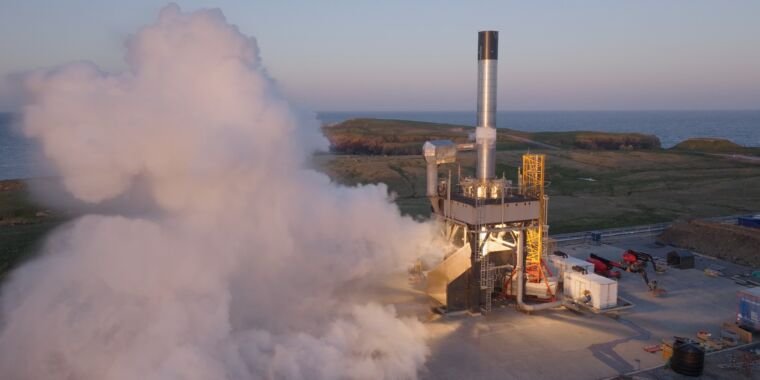A frontrunner in Europe’s private launch industry just lost its first rocket

The first stage of Rocket Factory Augsburg’s first orbital launcher was destroyed in a fireball during a test-firing Monday evening at a spaceport in Scotland, the company said.
The German launch startup aimed to send its first rocket into space later this year and appeared to be running ahead of several competitors in Europe’s commercial launch industry that are also developing rockets to deploy small satellites in orbit.
Within the last few months, Rocket Factory Augsburg (RFA) delivered all three stages of its first rocket, named RFA One, to its launch site at SaxaVord Spaceport, located on Unst, one of the Shetland Islands and the northernmost inhabited island in the United Kingdom. The company is based in Augsburg, Germany.
In July, RFA reported it completed acceptance and qualification testing on the rocket’s second and third stages, but the first stage had one more major test campaign ahead of it. The first stage fired four of its engines on the launch pad at SaxaVord in May, and over the summer, RFA engineers installed the booster’s full complement of nine engines for a full-power test-firing.
Setback at SaxaVord
In a statement, RFA said there was “an anomaly that led to the loss of the stage” Monday evening. The company said no one was injured and reported that the launch pad has been “saved and secured.” This was the same rocket RFA planned to launch on its inaugural test flight.
The hot fire test Monday was the first with all nine engines on RFA One’s first stage. A BBC video of the test showed a fireball erupting around the bottom of the booster as the engines ignited. It wasn’t clear if all nine engines fired. Moments later, the engines appeared to shut down as the fire grew larger, with a fountain of flames shooting out to the side of the rocket. Finally, the booster toppled from its mount and blew up as it hit the ground.
“We are now working closely with SaxaVord Spaceport and the authorities to gather data and info to eventually resolve what happened,” RFA said. “We will take our time to analyze and assess the situation.”
Earlier this month, the chief executive of the German aerospace company OHB, which owns nearly 65 percent of Rocket Factory Augsburg, said the full integration of the RFA One was imminent, followed by a launch attempt “in a matter of weeks,” according to Space News. The destruction of the first stage likely eliminates any chance of launching the RFA One rocket before the end of this year, and depending on the cause of the test failure, could result in a longer delay.
“We develop iteratively with an emphasis on real testing,” RFA said. “This is part of our philosophy, and we were aware of the higher risks attached to this approach. Our goal is to return to regular operations as soon as possible.”
“These tests are designed to identify faults and issues prior to a full test flight campaign and are all carried out in a highly controlled and regulated environment,” said Frank Strang, CEO of SaxaVord Spaceport, the first fully licensed vertical launch spaceport in Western Europe. “It is far too early to know what caused the anomaly, but I am confident that once RFA gets to the bottom of it, they will rectify the situation and carry on with their program.”
In July, US rocket company ABL Space Systems lost its second rocket after a similar test-firing on a launch mount in Alaska. ABL’s first rocket failed soon after liftoff in January 2023.
“Space is a high risk/high reward sector, and there will be lots of highs and lows in all our journeys,” Strang said in a statement. “This anomaly was inevitable and there will be more. As long as we all do our jobs to the best of our ability, then they will be resolved, we will all learn, and SaxaVord Spaceport and the space economy will grow.”
The RFA One rocket is made of a stainless steel structure, with nine Helix engines consuming kerosene and liquid oxygen propellants on the first stage. All nine engines will produce more than 200,000 pounds, or about 900 kilonewtons, of thrust at full power. One Helix engine will drive the second stage of the RFA One rocket, and a third stage, or orbital transfer vehicle, will complete the job of placing payloads into orbit.
Fully stacked, the rocket will stand 98 feet (30 meters) tall and will be capable of delivering payloads of up to 1.3 metric tons (nearly 2,900 pounds) into polar orbits. RFA is one of several European startups developing commercial small satellite launchers. The RFA One rocket is the most powerful launch vehicle of the group, and RFA was the first to deliver flight hardware to its launch site.
Source link




